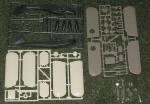
| KIT: | Matchbox 1/72 Supermarine Walrus Mk.I |
| KIT #: | PK 105 |
| PRICE: | $? |
| DECALS: | Two options |
| REVIEWER: | Scott Van Aken |
| NOTES: | Molded in three colors with a stand. Dated 1973 |

| HISTORY |
In 1929, the RAAF drew up specifications for a boat hulled amphibian aircraft. After a considerable delay, the prototype machine, known as a 'Seagull' flew in mid 1933. After successful trials, 24 were ordered.
In May of 1935, the Royal Navy placed an order for twelve aircraft and named it 'Walrus'; later increasing the numbers ordered as the effectiveness of the aircraft became apparent. Walrus I's performed a number of duties including anti-submarine patrols, ship board gunnery spotting and other typical catapult aircraft services. In the hands of the RAF, these aircraft were used with great success as air/sea rescue aircraft. Affectionately known as 'Shagbats', countless aviators owe their lives to rescue by these airplanes. They served until the end of WWII in all theaters of operation. .
| THE KIT |
 Nearly
all Matchbox kits have one thing in common. They are designed to be easy to
build with a minimum of fussiness. Though not quite the ease as the series 1
kits, the series 2 versions are all highlighted by having their parts molded in
three colors instead of just two. They also introduce more complex kits.
Nearly
all Matchbox kits have one thing in common. They are designed to be easy to
build with a minimum of fussiness. Though not quite the ease as the series 1
kits, the series 2 versions are all highlighted by having their parts molded in
three colors instead of just two. They also introduce more complex kits.
Often characterized by the 'mad trencher', this kit has little in the way of engraved lines aside from control surfaces and doors/hatches. The detailing in this case is finely raised and unless you are truly fussy, will make no difference in the look of the finished model. Fabric surfaces are the usual 'hills and valleys', but to a lesser extent that seen on some kits. The interiors are as basic as you can get with little more than a generic seat on which to place the crewman. You can even reduce the number of crew by covering over the front and rear gunner's positions, though you'll need a touch of surgery to do the aft one as it is designed to be in the open position.
I am happy to say that I found almost no sink areas and
no flash at all. This is undoubtedly one of the earlier moldings to be so clean.
Should you wish, you can put the wheels up and mount it on the included display
stand. The engine is rather generic looking, but quite acceptable. The engine
mounts are one-piece to be sure that you are able to get things in the proper
alignment. Separate struts are provided for the outer wings, but the engine
mounting should provide sufficient
 sturdiness to get these bits in
their proper place. Rigging is rather extensive for a single-bay biplane, with
the box art providing a guide.
sturdiness to get these bits in
their proper place. Rigging is rather extensive for a single-bay biplane, with
the box art providing a guide.
Instructions are early Matchbox with construction sequences devoid of any color information, that being provided on a separate chart at the end. Markings are given for two aircraft. One is an overall Aluminum plane as shown on the box top as being from the HMS Sheffield in 1938. The second is from 283 Squadron in Italy during 1944 and is in the Extra Dark Sea Grey/Slate Grey over Sky finish. Decals are usable though considering their age, I'd have back-ups. For some odd reason, the previous owner of this kit had cut out sections of the sheet, which had curled considerably. Made it hard to get any sort of a scan.
| CONCLUSIONS |
Unless Pavla or someone else has done one in the last few years, this and the Airfix kit are about it. Both are not difficult to find, even though they are out of production (for the time being). Of the two, this one will be the easiest to build and should provide you with a most interesting model when done.
August 2006
If you would like your product reviewed fairly and quickly by a site that has over 300,000 visitors a month, please contact me or see other details in the Note to Contributors.